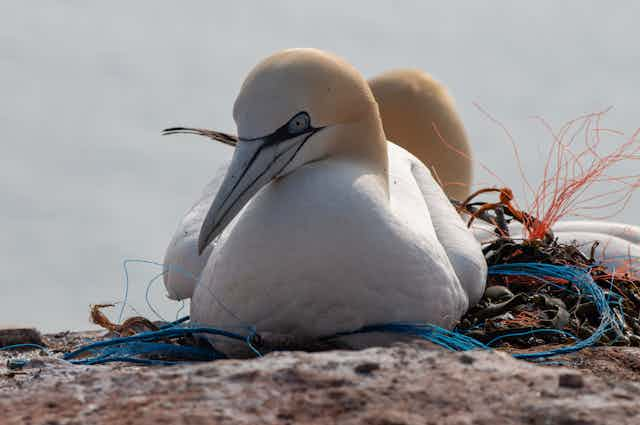Interactions between wildlife and plastic litter have been well documented in the sea. Think of seals entangled in netting or whales permanently attached to discarded fishing tackle, so-called “ghost gear”.
But it is birds that may encounter discarded human-made material the most of all animal groups, as they are extremely mobile and can be found almost everywhere in the world. There are many reports of seabird chicks dying after being entangled in old plastic and fishing nets, for instance.
Another cause of their deaths was documented in an upsetting series of photographs of Laysan albatrosses from Midway Atoll in the Pacific. Adult birds spend years in flight over the open waters, returning to land only to breed. Some had mistaken plastic for fish or squid, ingested it and then fed it to their young which then died. It seems that even these most enigmatic of seabirds – they live as long as we do and often breed with the same partner for life – are not immune from encounters with human-made materials.

Nest-building birds are adapting
The media tends to focus on the accumulation of plastic on beaches and the resulting negative impacts on wildlife. But in our latest research we instead wanted to investigate how birds have actually adapted to live alongside such materials.
The breeding success of birds is often tightly linked to nest functionality, and we wanted to understand if human-made materials obtained by nest-building adults could be playing an important role. And if so, we wanted to know which birds use these materials, whether some materials are favoured over others and if biological characteristics of species – their size, experience, behaviour and so on – predispose them to using such materials in their nests.

We searched more than a century of peer-reviewed scientific literature using terms such as “anthropogenic” or “artificial material” and “nest”, identifying 2,771 relevant papers. Retaining only those studies that described the use of human-made materials by nesting birds, we found evidence of this behaviour in almost 35,000 nests of 176 bird species, reported in 75 papers. These species occurred on all continents except Antarctica.
This suggests that such behaviour is widespread among birds, including ducks, birds of prey, gulls, cormorants and many songbirds. We were surprised to discover that the earliest observations were made back in the 1830s. We identified plastic as the most important type of material, but we also found evidence of cloth, paper, metal and more.
Some birds are doing it intentionally
To test several hypotheses that might explain this interesting behaviour we used statistical models which examined whether the use of anthropogenic nest materials was related to species’ biology. We found that plastic and other human-made products were more likely to be found in nests of species with larger differences in body size between males and females, and in those that build complex domed nests. Both findings supported the idea that nest materials signal the quality of breeding adults and would imply that human-made materials are being included in nests intentionally – the birds are showing off.
Although not in a nesting context, some support for these findings comes from the bowerbirds of New Guinea and Australia. The males now use human-made items in their bowers (a specially built structure) to court females by demonstrating their “quality” as potential mates.

Unexpectedly, neither how long a species lives for, nor whether a nest was built in new human-made habitats, appeared to explain the presence of such materials in nests. It seems that experience does not favour the use of plastics and other materials in nests. We also found no separate and distinct evolutionary lineages that preferentially use human-made materials in nests, suggesting that many other bird species may have the potential to do so.
What next?
Many birds, including birds of prey, gulls and pigeons, are urban-adapted and breed successfully in cityscapes where human-made materials are readily available. The extent to which birds adapt to polluted environments remains underappreciated because a study like ours is only as good as the available data. We encourage researchers to collect data from nests of many more species but to do so in a standardised way to allow for sound comparisons between studies and species.
Of all animal species, birds are perhaps best placed as “bio-indicators” of environmental pollution. None of us wants wild animals to be forced to interact with human-made materials, of course. But these behavioural adaptations at least provide us ornithologists with a wonderful opportunity to monitor a changing environment.

Don’t have time to read about climate change as much as you’d like?
Get a weekly roundup in your inbox instead. Every Wednesday, The Conversation’s environment editor writes Imagine, a short email that goes a little deeper into just one climate issue. Join the 20,000+ readers who’ve subscribed so far.

